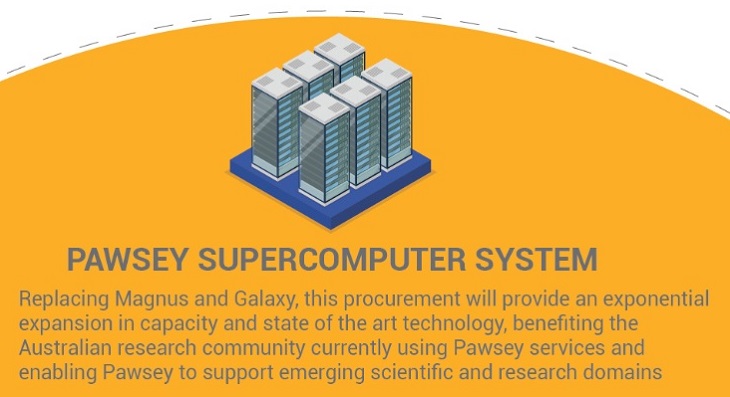Feb. 27, 2020 — HPE has been selected by the Pawsey Supercomputing Centre in Perth to deliver a new $2 million (AUD) compute cluster that will support one of the Square Kilometre Array precursor projects in Australia, the Murchison Widefield Array (MWA) radio telescope.
 The new 78-node cluster will provide a dedicated system for astronomers to process in excess of 30 PB – equal to 399 years of high definition video – of MWA telescope data using Pawsey infrastructure.
The new 78-node cluster will provide a dedicated system for astronomers to process in excess of 30 PB – equal to 399 years of high definition video – of MWA telescope data using Pawsey infrastructure.
The new cluster will provide users with enhanced GPU capabilities to power AI, computational work, machine learning workflows and data analytics.
The MWA and another SKA precursor telescope – ASKAP – are located at the Murchison Radio-astronomy Observatory in remote Western Australia, which is owned and operated by Australia’s national science agency, CSIRO.
Until now processing of data collected by both the MWA and ASKAP telescopes has been done on Galaxy, Pawsey’s real-time supercomputing system dedicated to radio astronomy.
However, the data processing needs of both instruments has been growing: MWA has doubled the number of antennas available, and ASKAP will soon be ready to undertake full surveys of the sky.
To meet this growing demand, the new MWA cluster has been procured ahead of the main supercomputing system, as part of a $70 million Pawsey capital refresh project funded by the Australian Government.
 Mark Stickells, Pawsey executive director, said the upgrade will allow Pawsey to deliver a service that is tailored to the Australian scientific landscape, and to keep pace with global advances in supercomputing technology.
Mark Stickells, Pawsey executive director, said the upgrade will allow Pawsey to deliver a service that is tailored to the Australian scientific landscape, and to keep pace with global advances in supercomputing technology.
“Procurement of the new MWA cluster was the result of a thorough consultation process with key stakeholders and will provide the best system possible to respond to the specific needs of MWA telescope users,” he said.
“The new MWA cluster at Pawsey will feature 156 of the latest generation of Intel CPUs and 78 cutting-edge GPUs with more high-bandwidth memory, internal high-speed storage and more memory per node.”
About the importance of this process and its results, Professor Melanie Johnston-Hollitt, MWA director, said “As the MWA Director, I am delighted to see the conclusion of the procurement process, it was an outstanding example of collaboration between Pawsey and MWA and I am glad we had the opportunity to provide input into Australia’s HPC future.”
“As a researcher, I am excited that this new infrastructure will give us the chance to accelerate our workflows, leading to faster scientific discoveries and for providing the opportunity to continue to use the MWA as a scientific, technical, and operational testbed for the future Square Kilometre Array,” she concluded.
The Pawsey Supercomputing Centre’s 546 teraflops MWA cluster will comprise 78 nodes, each with two Intel Xeon Gold 6230 processors operating at 2.1 GHz and providing forty compute cores in total, a single NVIDIA V100 with 32 GB of high-bandwidth memory, 960 GB of local NVMe storage and 384 GB of main memory.
HPE was chosen not only because they successfully meet MWA’s technical requirements, but also their ability to leverage resources around the world to provide the highest level of support for the lifetime of the system in addition to their local support.
They provided the most space-efficient solution, only requiring two racks, which saves on floor space as well as power and cooling connections.
Commissioning of the new MWA cluster system is expected to be finalised by Q2 2020.
The Pawsey Supercomputing Centre is an unincorporated joint venture of CSIRO – Australia’s national science agency, Curtin University, Edith Cowan University, Murdoch University and the University of Western Australia. The procurement of this system was conducted by CSIRO as the centre agent for Pawsey.
About Pawsey Supercomputing Centre
The Pawsey Supercomputing Centre is a world-class high-performance computing facility accelerating scientific discoveries for Australia’s researchers. Pawsey is currently serving over 40 organisations and achieving unprecedented results, in domains such as radio astronomy, energy and resources, engineering, bioinformatics and health sciences.
The Pawsey Capital Refresh project is supported by the Australian Government through a $70 million grant. Pawsey is also supported by the Australian Government under the National Collaborative Research Infrastructure Strategy (NCRIS) through the Department of Education. The Centre would also like to acknowledge the support provided by the Western Australian Government and its Partner organisations.
Source: Pawsey Supercomputing Centre




























































